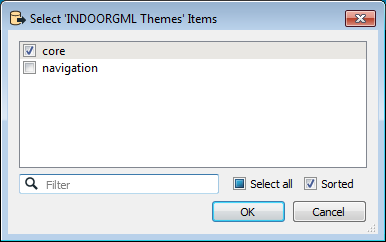IndoorGML Themes
- by Themes(default): The INSPIRE Themes parameter takes effect.
- by XSD: A different INSPIRE schema (other than the built-in themes) may be specified via the Application Schema parameter.
begin snippet
- by Themes(default): Enables the IndoorGML Themes parameter.
- by XSD: This option enables the Application Schema parameter, where you can specify a different IndoorGML schema (other than the built-in themes).
When reading schema features or importing feature type definitions into the IndoorGML writer, the IndoorGML reader dataset parameter may be left unset.
Select from the available IndoorGML themes.

Note: An explicit path to a different IndoorGML schema with the definitions for the appropriate theme or layer can be specified in the Application Schema parameter.
When the by XSD parameter is selected, this parameter specifies the location of the IndoorGML .xsd document.
end snippet
SRS Parameters
This parameter can overwrite the CRS value that is written in the GML instance’s srsName attributes.
By default, the FME coordinate system name in a feature is transferred directly onto the srsName attribute. Using this parameter allows you to provide your own URN CRS string for the srsName attributes.
This parameter is required in conjunction with the GML srsName parameter. It specifies the axis order for a coordinate tuple in a GML <pos> or <posList> element.
The valid values are
- 1,2
- 2,1
- 1,2,3
- 2,1,3
There is no default value.
For example, if GML srsName is set to urn:ogc:def:crs:EPSG:6.6.4326, this parameter should be set to “2,1” so that the coordinates in the GML <pos> and <posList> elements are written in lat-lon order.
Pretty Printing
Setting this parameter to Yes ensures the output is neatly formatted. This promotes easier reading on screen and in print output.
- Indent Size: Select a value from 0 to 9.
- Replace Tabs with Spaces: By default the Tab character is used to for indentations. Select Yes to substitute the Tab character with a Space.
Note: Enabling this option produces a considerably larger output file due to added whitespace.
Feature Properties
Specifies whether the default and optional GML feature properties, name and description, should be read.
Feature Properties – Attribute Handling
Specifies whether GML properties that are defined as a complex type with complex content (that is, those that have embedded children elements) should be mapped as nested list attributes within FME features.
If the value is set to XML Fragments, then the complex properties with complex content are mapped as XML fragments.
Some complex properties, such as those that are recursively defined, cannot be mapped as nested lists. These complex properties will always be mapped as XML fragments, regardless of the setting for this parameter.
This optional parameter can control the depth of nested list attributes.
Advanced
Specify the maximum number of decimal place to write to the GML file when writing coordinates.
To specify an exact number of decimal places to write, use this parameter in conjunction with the Minimum Decimal Places parameter.
Value
An integer greater than or equal to 0.
Default value: 15 decimal places.
Specify the minimum number of decimal place write to the GML file when writing coordinates.
To specify an exact number of decimal places to write, use this parameter in conjunction with the Maximum Decimal Places parameter.
Value
An integer greater than or equal to 0.
Default value: 0 decimal places.
This parameter specifies the encoding for the incoming schema and data feature (for example, UTF-8).
If unspecified, the writer assumes that the schema and data features are encoded with the system’s encoding.
This parameter suppresses the output of the xsi:schemaLocation attribute in the GML instance’s root element. The xsi:schemaLocation in an XML document instance is not a mandatory attribute – it is merely a hint that an XML processor may choose to ignore.
Setting this parameter to Yes suppresses the output of the xsi:schemaLocation attribute in the output GML instance. The default setting is No.
Use Network Authentication
This parameter is always visible in some formats, and visible in other formats only when the dataset is a URL.
Specify the authentication method to use when accessing a password-protected server.
- Basic: (default) Basic access authentication is designed to allow a client to provide credentials to a server on the assumption that the connection between them is trusted and secure. Note that any credentials passed from client to server can be easily intercepted through an insecure connection.
- Digest: Digest authentication is one of the agreed-upon methods a web server can use to negotiate credentials, such as username or password, with a user's web browser.
- NTLM: A challenge-response protocol that is used to provide compatibility with versions of Windows earlier than the Windows 2000 operating systems.
- Web Connection: Web connections provide a convenient and secure way to store and reuse previously established connection parameters. See Web Connection below.
- Single Sign-on: FME will use the credentials of the current user to authenticate the HTTP request. This authentication method currently works only on the Windows operating system.